Creating Capsule Wardrobes from Fashion Images
Wei-Lin Hsiao
UT-Austin
Kristen Grauman
UT-Austin
kimhsiao@cs.utexas.edu
grauman@cs.utexas.edu
Abstract
We propose to automatically create capsule wardrobes.
Given an inventory of candidate garments and accessories,
the algorithm must assemble a minimal set of items that pro-
vides maximal mix-and-match outfits. We pose the task as
a subset selection problem. To permit efficient subset selec-
tion over the space of all outfit combinations, we develop
submodular objective functions capturing the key ingredi-
ents of visual compatibility, versatility, and user-specific
preference. Since adding garments to a capsule only ex-
pands its possible outfits, we devise an iterative approach
to allow near-optimal submodular function maximization.
Finally, we present an unsupervised approach to learn vi-
sual compatibility from “in the wild” full body outfit pho-
tos; the compatibility metric translates well to cleaner cat-
alog photos and improves over existing methods. Our re-
sults on thousands of pieces from popular fashion websites
show that automatic capsule creation has potential to mimic
skilled fashionistas in assembling flexible wardrobes, while
being significantly more scalable.
1. Introduction
The fashion domain is a magnet for computer vision.
New vision problems are emerging in step with the fash-
ion industry’s rapid evolution towards an online, social, and
personalized business. Style models [22, 38, 34, 17, 27],
trend forecasting [1], interactive search [44, 24], and rec-
ommendation [41, 18, 31] all require visual understanding
with rich detail and subtlety. Research in this area is poised
to have great influence on what people buy, how they shop,
and how the fashion industry analyzes its enterprise.
A capsule wardrobe is a set of garments that can be as-
sembled into many visually compatible outfits (see Fig. 1).
Capsules are currently the purview of fashion experts, mag-
azine editors, and bloggers. A capsule creator manually an-
alyzes an inventory to puzzle together a relatively small set
of clothing items and accessories that mix and match well.
A curated capsule can help consumers get the best value
for their dollars (“do more with less”), help vendors pro-
Figure 1: A capsule wardrobe is a minimal set of garments that
can mix and match to compose many visually compatible outfits.
pose appealing wardrobes from their catalogs, and help a
subscription service (e.g., StitchFix, LeTote) ship a targeted
box that amplifies a customer’s wardrobe.
We propose to automate capsule wardrobe generation.
There are two key technical challenges. First, capsules
hinge on having an accurate model of visual compatibil-
ity. Whereas visual similarity asks “what looks like this?”,
and is fairly well understood [11, 32, 42, 30], compatibil-
ity instead asks “what complements this?” It requires cap-
turing how multiple visual items interact, often according
to subtle visual properties. Existing compatibility meth-
ods [41, 14, 35, 16, 31, 39] assume supervision via labels or
co-purchase data, which limits scope and precision, as we
will discuss in Sec. 3. Furthermore, they largely cater only
to pairwise compatibility. The second challenge is that cap-
sule generation is a complex combinatorial problem. Of all
possible garments, we seek the subset that maximizes ver-
satility and compatibility, and, critically, the addition of any
one garment introduces multiple new outfit combinations.
We introduce an approach to automatically create cap-
sule wardrobes that addresses both of these issues. We first
cast capsule creation as a subset selection problem. We de-
1
Capsule piecesOutfit #1Outfit #2Outfit #3Outfit #4Outfit #5In Proceedings of the IEEE Conference on Computer Vision and Pattern Recognition (CVPR), 2018�
fine an objective function characterizing a capsule based on
its pieces’ mutual compatibility, the resulting outfits’ versa-
tility, and (optionally) its faithfulness to a user’s preferred
style. Then, we develop an efficient algorithm that maps a
large inventory of candidate garments into the best capsule
of the desired size. We design objectives that are submod-
ular for the addition of new outfits, ensuring the “diminish-
ing returns” property that facilitates near-optimal set selec-
tion [36, 28]. Then, since each garment added to a capsule
expands the possible outfits, we further develop an iterative
approach that exploits outfit submodularity to alternate be-
tween fixing and selecting each layer of clothing.
As a second main contribution, we introduce an unsuper-
vised approach to learn visual compatibility from full-body
images “in the wild”. We learn a generative model for outfit
compositions from unlabeled images that can score k-way
compatibility. Because it is built on predicted attributes, our
model can translate compatibility learned from the “in the
wild” photos to cleaner catalog photos of individual items,
where users need most guidance on mixing and matching.
We evaluate our approach on thousands of garments
from Polyvore, popular social commerce websites for fash-
ion. We compare our algorithm’s capsule creations to those
manually defined by fashionistas, as well as subjective user
studies. Furthermore, we show our underlying compatibil-
ity model offers advantages over some state of the art meth-
ods. Finally, we demonstrate the practical value of our al-
gorithm, which in seconds finds near-optimal capsules for
problem scales that are otherwise intractable.
2. Related Work
Attributes for fashion Attributes offer a natural repre-
sentation for clothing, since they can describe relevant pat-
terns (checked, paisley), colors (rose, teal), fit (loose), and
cut (V-neck, flowing) [4, 2, 8, 43, 6, 23, 33]. Topic models
on attributes are indicative of styles [20, 40, 17]. Inspired
by [17], we employ topic models. However, whereas [17]
seeks a style-coherent image embedding, we use correlated
topic models to score novel combinations of garments for
their compatibility. Domain adaptation [6, 19] and multi-
task curriculum learning [9] are valuable to overcome the
gap between street and shop photos. We devise a simple
curriculum learning approach to train attributes effectively
in our setting. None of the above methods explore visual
compatibility or capsule wardrobes.
Style and fashionability Beyond recognition tasks,
fashion also demands answering: How do we represent
style? What makes an outfit fashionable? The style of an
outfit is typically learned in a supervised manner. Lever-
aging style-labeled data like HipsterWars [22] or Deep-
Fashion [33], classifiers built on body keypoints [22],
weak meta-data [38], or contextual embeddings [27] show
promise. Fashionability refers specifically to a style’s pop-
ularity. It can also be learned from supervised data, e.g.,
online data for user “likes” [29, 37]. Unsupervised style
discovery methods instead mine unlabeled photos to detect
common themes in people’s outfits, with topic models [17],
non-negative matrix factorization [1], or clustering [34]. We
also leverage unlabeled images to discover “what people
wear”; however, our goal is to infer visual compatibility for
unseen garments, rather than trend analysis [1, 34] or image
retrieval [17] on a fixed corpus.
Compatibility and recommendation Substantial prior
work explores ways to link images containing the same or
very similar garment [11, 32, 42, 21, 30]. In contrast, com-
patibility requires judging how well-coordinated or comple-
mentary a given set of garments is. Compatibility can be
posed as a metric learning problem [41, 35, 16], addressable
with Siamese embeddings [41] or link prediction [35]. Text
data can aid compatibility [29, 39, 14]. As an alternative
to metric learning, a recurrent neural network models outfit
composition as a sequential process that adds one garment
at a time, implicitly learning compatibility via the transition
function [14]. Compatibility has applications in recommen-
dation [31, 18], but prior work recommends a garment at a
time, as opposed to constructing a wardrobe.
To our knowledge, all prior work requires labeled data
to learn compatibility, whether from human annotators cu-
rating matches [14, 18], co-purchase data [41, 35, 16], or
implicit crowd labels [29]. In contrast, we propose an un-
supervised approach, which has the advantages of scalabil-
ity, privacy, and continually refreshable models as fashion
evolves, and also avoids awkwardly generating “negative”
training pairs (see Sec. 3). Most importantly, our work
is the first to develop an algorithm for generating capsule
wardrobes. Capsules require going beyond pairwise com-
patibility to represent k-way interactions and versatility, and
they present a challenging combinatorial problem.
Subset selection We pose capsule wardrobe generation
as a subset selection problem. Probabilistic determinantal
point processes (DPP) can identify the subset of items that
maximize individual item “quality” while also maximizing
total “diversity” of the set [25], and have been applied for
document and video summarization [25, 12]. Alternatively,
submodular function maximization exploits “diminishing
returns” to select an optimal subset subject to a budget [36].
For submodular objectives, an efficient greedy selection cri-
terion is near optimal [36], e.g., as exploited for sensor
placement [13] and outbreak detection [28]. We show how
to adapt such solutions to permit accurate and efficient se-
lection for capsule wardrobes; furthermore, we develop an
iterative EM-like algorithm to enable non-submodular ob-
jectives for mix-and-match outfits.
�
3. Approach
We first formally define the capsule wardrobe problem
and introduce our approach (Sec. 3.1). Then in Sec. 3.2
we present our unsupervised approach to learn compatibil-
ity and personalized styles, two key ingredients in capsule
wardrobes. Finally, in Sec. 3.3, we overview our training
procedure for cross-domain attribute recognition.
3.1. Subset selection for capsule wardrobes
i
s0
i , s1
i , ..., sNi−1
A capsule wardrobe is a minimal set of garments that
combine in versatile ways to create many compatible out-
fits (see Fig. 1). We cast capsule creation as the problem of
selecting a subset from a large set of candidates that maxi-
mizes quality (compatibility) and diversity (versatility).
3.1.1 Problem formulation and objective
We formulate the subset selection problem as follows.
Let i = 0, . . . , (m − 1) index the m layers of clothing
(e.g., outerwear, upper body, lower body, hosiery). Let
denote the set of candidate gar-
Ai =
ments/pieces in layer i, where sj
i , j = 0, . . . , (Ni − 1) is
the j-th piece in layer i, and Ni is the number of candidate
pieces for that layer. For example, the candidates could be
the inventory of a given catalog. If an outfit is composed of
one and only one piece from each layer, the candidate pieces
in total could generate a set Y of
Objective To form a capsule wardrobe, we must select
only T pieces, AiT =
⊆ Ai from each layer
i. The set of outfits y generated by these pieces consists of
A0T × A1T × . . . × A(m−1)T . Our goal is to select the
pieces A∗iT ,∀i such that their composed set of outfits y∗ is
maximally compatible and versatile. Fig. 2 visualizes this
problem.
i Ni possible outfits.
sj1
i , ..., sjT
i
To this end, we define our objective as:
y∗ = argmax
C(y) + V (y),
y⊆Y
(1)
s.t. y = A0T × A1T × . . . × A(m−1)T
T
where C(y) and V (y) denote the compatibility and versa-
tility scores, respectively.
A na¨ıve approach to find the optimal solution y∗ re-
quires computation on T m outfits in a subset, multiplying
m to search through all possible subsets. Since our
byN
candidate pool may consist of all merchandise in a shopping
site, N may be on the order of hundreds or thousands, so op-
timal solutions become intractable. Fortunately, our key in-
sight is that as wardrobes expand, subsequent outfits add di-
minishing amounts of new styles/looks. This permits a sub-
modular objective that allows us to obtain a near-optimal
solution efficiently. In particular, greedily growing a set for
subset selection is near-optimal if the objective function is
submodular; the greedy algorithm is guaranteed to reach a
Figure 2: Selecting a subset of pieces from the candidates to form
a capsule wardrobe. Left shows candidates from all layers. The
selected pieces are checked and compose the subset on the right.
e , or about
solution achieving at least a constant fraction 1− 1
63%, of the optimal score [36].
Definition 3.1 Submodularity. A set function F is submod-
ular if, ∀D ⊆ B ⊆ V , ∀s ∈ V \ B, F (D ∪{s})− F (D) ≥
F (B ∪ {s}) − F (B).
Submodularity satisfies diminishing returns. Since it is
closed under nonnegative linear combinations, if we design
C(y) and V (y) to be submodular, our final objective will
be submodular as well, as we show next.
We stress that items in a subset y are outfits—not gar-
ments/pieces. The capsule is the Cartesian product of all
garments selected per layer. Therefore, when greedily
growing a set at time step t, an incremental addition of one
garment sjt
i=i Ai(t−1)
new outfits. While ultimately the algorithm must add gar-
ments to the capsule, for the sake of optimization, it needs
to reason about the set in terms of those garments’ combi-
natorial outfits. We address this challenge below.
i from layer i entails adding sjt
i ×
Compatibility Suppose we have an algorithm that re-
turns the compatibility estimate c(oj) of outfit oj (to be de-
fined in Sec. 3.2). We define a set’s compatibility score as:
C(y) := Σoj∈yc(oj),
(2)
the sum of compatibility scores for all its outfits. C(y) is
modular, a special case of submodularity, since an addi-
tional outfit oj to any set y will increase C(y) by the same
amount c(oj).
Versatility A good capsule wardrobe should offer a va-
riety of looks, or styles, for different uses and occasions. We
formalize versatility as a coverage function over all styles:
V (y) := ΣK
i=1vy(zi)
(3)
where vy(zi) measures the degree to which outfits in y
cover the i-th desired style zi, and K is the total number
of distinct styles. Sec. 3.2 will define our model for styles
zi. To satisfy the diminishing returns property, we define
vy(i) probabilistically:
vy(zi) := 1 −
(1 − P (zi|oj)),
(4)
oj∈y
OuterLower………………CandidateCapsule……Layersi=m�1i=0s00sj0s10sN0�10s0m�1s1m�1sjm�1sN(m�1)�1m�1A0A0TA(m�1)A(m�1)Tsj10sjT0sjTm�1sj1m�1�
where P (zi|oj) denotes the probability of a style zi given
an outfit oj. We define a generative model for P (zi|oj) be-
low. The idea is that each outfit “tries” to cover a style with
probability P (zi|oj), and the style is covered by a capsule
if at least one of the outfits in it successfully covers that
style. Thus, as y expands, subsequent outfits add diminish-
ing amounts of style coverage. A probabilistic expression
for coverage is also used in [10] for blog posts.
We have thus far defined versatility in terms of uniform
coverage over all K styles. However, each user has his/her
own preferences, and a universally versatile capsule may
contain pieces that do not meet one’s taste. Thus, as a per-
sonalized variant of our approach, we adjust each style’s
proportion in the coverage function by a user’s style prefer-
ence. This extends our capsules with personalized versatil-
ity:
i=1wivy(zi),
V (y) := ΣK
(5)
where wi denotes a personalized preference for each style
i. Sec. 3.2 explains how the personalization weights are
discovered from user data.
3.1.2 Optimization
A key challenge of subset selection for capsule wardrobes
is that our subsets are on outfits, but we must form the sub-
set by selecting garments. With each garment addition, the
subset of outfits y grows superlinearly, since every new gar-
ment can combine with all previous garments to form new
outfits. Submodularity requires each addition to diminish a
set function’s gain, but adding more garments yields more
outfits, so the gain actually increases. Thus, while our ob-
jective is submodular for adding outfits, it is not submodular
for adding individual garments. However, we can make the
following claim:
Claim 3.2 When fixing all other layers (i.e., upper, lower,
outer) and selecting a subset of pieces one layer at a time,
the probabilistic versatility coverage function in Eqn (3) is
submodular, and the compatibility function in Eqn (2) is
modular. See Supplementary File for proof.
Thus, given a single layer, our objective function is sub-
modular for garments. By fixing all selected pieces in other
layers, any additional garment will be combined with the
same set of garments and form the same amount of new
outfits. Thus subsets in a given layer no longer grow super-
linearly. So the guarantee of a greedy solution on that layer
being near-optimal [36] still holds.
To exploit this, we develop an EM-like iterative approach
to approximate a greedy solution over all layers: we itera-
tively fix the subsets selected in other layers, and focus the
current selection in a single layer. After sufficient iterations,
our subsets converge to a fixed set. Algorithm 1 gives the
complete steps.
Our algorithm is quite efficient. Whereas a na¨ıve search
would take more than 1B hours for our data with N = 150,
cur := 0
Reset selected pieces in layer i
ε is the tolerance degree for convergence
for each layer i = 0, 1, ...(m − 1) do
yt−1 = Ai(t−1) ×
obj ≥ ε do
AiT = Ai0 := ∅
obji
for each time step t = 1, 2, ...T do
i=i AiT
δs
Algorithm 1 Proposed iterative greedy algorithm for sub-
modular maximization, where obj(y) := C(y) + V (y).
1: AiT := ∅, ∀i
2: ∆obj := ε + 1
3: objm−1
prev := 0
4: while ∆m−1
5:
6:
7:
8:
9:
10:
11:
12:
13:
14:
15:
16:
17:
18: end while
19: procedure INCREMENTAL ADDITION (yt := yt−1 s)
20:
21:
22:
23:
24:
25:
26:
27: end procedure
t := s, s ∈ Ai \ Ai(t−1)
y+
for j ∈ {1, . . . , m} , j = i do
if AjT = ∅ then
:= argmaxs∈Ai\Ai(t−1)
sjt
i
where δs = obj(yt−1 s) − obj(yt−1)
Ait := sjt
obji
end for
i ∪ Ai(t−1)
cur + δ
end for
∆m−1
objm−1
:= objm−1
prev := objm−1
cur − objm−1
prev
y+
t := y+
end if
end for
yt := yt−1 ∪ y+
t
cur := obji
sjt
i
Max increment
Update layer i
obj
cur
t × AjT
our algorithm returns an approximate capsule in only 200
seconds. Most computation is devoted to computing the ob-
jective function, which requires topic model inference (see
below). A na¨ıve greedy approach on garments would re-
quire O(N T 4) time for m = 4 layers, while our itera-
tive approach requires O(N T 3) time per iteration (details
in Supp.) For our datasets, it requires just 5 iterations.
3.2. Style topic models for compatibility
Having defined the capsule selection objective and opti-
mization, we now present our approach to model versatility
(via P (zi|oj)) and compatibility c(oj) simultaneously.
Prior work on compatibility takes a supervised approach.
Given ground truth compatible items (either by manual la-
bels like curated sets of product images on Polyvore [29, 39,
14] or by using Amazon co-purchase data as a proxy [35,
41, 16]), a (usually discriminative) compatibility metric is
trained. See Fig. 3. However, the supervised strategy has
weaknesses. First, items purchased at the same time can be
a weak proxy for visual compatibility. Second, user-created
sets often focus on the visualization of the collage, usually
contain fewer than two main (non-accessory) pieces, and
lack layers like hosiery. Third, sources like Amazon and
Polyvore are limited to brands selected by vendors, a frac-
tion of the wide variety of clothing people wear in real life.
Fourth, obtaining the negative non-compatible examples re-
�
Figure 3: L to R: Amazon co-purchase example; Polyvore user-
curated set; Chictopia full-body outfit (our training source).
quired by supervised discriminative methods is problem-
atic. Previous work [35, 41, 16, 29, 39] generates negative
examples by randomly swapping items in positive pairs, but
there is no guarantee that the random combinations are true
negatives. Not observing a pair of items together does not
necessarily mean they do not go well together.
To address these issues, we propose a generative compat-
ibility model that is learned from unlabeled images of peo-
ple wearing outfits “in the wild” (Fig. 3, right). We explore a
topic model—namely Correlated Topic Models (CTM) [26]
—from text analysis. CTM is a Bayesian multinomial mix-
ture model that supposes a small number of K latent topics
account for the distribution of observed words in any given
document.
It uses the following generative process for a
corpus D consisting of M documents each of length Li:
1. Choose ηi ∼ N (µ, Σ), where i ∈ {1, . . . , M} and
µ, Σ a K-dimensional mean and covariance matrix.
θik = eηik
k=1eηik maps ηi to a simplex.
2. Choose ϕk ∼ Dir(β), where k ∈ {1, . . . , K} and
Dir(β) is the Dirichlet distribution with parameter β.
3. For each word indexed by (i, j),
ΣK
where j ∈ {1, . . . , Li}, and i ∈ {1, . . . , M}.
(a) Choose a topic zi,j ∼ Multinomial(θi).
(b) Choose a word xi,j ∼ Multinomial(ϕzi,j ).
Only the word occurrences are observed. Following [17],
we map textual topic models to visual ones: a “document”
is an outfit, a “word” is an inferred visual attribute (e.g., flo-
ral, chiffon), and a “topic” is a style. The model discovers
the compositions of visual cues (i.e., attributes) that char-
acterize styles. A topic might capture plaid blue blouses,
or tight leather skirts. Prior work [17] models styles with a
Dirichlet prior, which treats topics within an image as inde-
pendent. For compatibility, we find CTM’s logistic normal
prior above [26] beneficial to account for style correlations
(e.g., a formal blazer is more likely to be combined with a
skirt than sporty leggings.)
CTM estimates the latent variables by maximizing the
Li
posterior distribution given a corpus D:
p(θ, z|D, µ, Σ, β) =
p(θi|µ, Σ)
M
i=1
j=1
p(zij|θi)p(xij|zij, β).
(6)
First we find the latent variables that fit assembled outfits
on full-body images. Next, given an arbitrary combination
of catalog pieces, we predict their attributes, and take the
union of attributes on all pieces to form an outfit oj. Finally
we infer its compatibility by the likelihood:
c(oj) := p(oj|µ, Σ, β).
(7)
Combinations similar to previously assembled outfits D
will have higher probability. For this generative model, no
negative examples need to be contrived. The training pool
should be outfits like those we want the model to emulate;
we use full-body photos posted to a fashion website.
Given a database of unlabeled outfit images, we pre-
dict their attributes. Then we apply CTM to obtain a set
of styles, where each style k is an attribute distribution
ϕk. Given an outfit oj, CTM infers its style composition
θoj = [θoj 1, . . . , θoj K]. Then we have:
P (zi|oj) := P (zi|θoj ) = θoj i,
(8)
p
p
which is used to compute our versatility coverage in Eq (4).
We personalize the styles emphasized for a user in Eq (5)
as follows. Given a collection of outfits {oj1 , . . . , ojU}
owned by a user p, e.g., as shown in that user’s purchase his-
tory catalog photos or his/her album on a fashion website,
we learn his/her style preference θ(user)
by aggregating all
U Σjθoj . Hence, a user’s personalized
outfits θ(user)
weight wi for each style i is θ(user)
= 1
Unlike previous work that uses supervision from human
created matches or co-purchase information, our model is
fully unsupervised. While we train attribute models on a
disjoint pool of attribute labeled images, our topic model
runs on “inferred” attributes, and annotators do not touch
the images from which we learn compatibility.
3.3. Cross-domain attribute recognition
pi
.
Finally, we describe our approach to infer cross-domain
attributes on both catalog and outfit images.
Vocabulary and data collection Since fine-grained at-
tributes are valuable for style, we build our vocabulary on
the 195 attributes enumerated in [17]. Their dataset has at-
tributes labeled only on outfit images, so we collect cata-
log images labeled with the same attribute vocabulary. To
gather images, we use keyword search with the attribute
name on Google, then manually prune those where the at-
tribute is absent. This yields 100 to 300 positive training
images per attribute, in total 12K images. (Details in Supp.)
Curriculum learning from shop to street Catalog im-
ages usually have a clear background, and are free of tricky
lighting conditions and deformations from body pose. As
a result, attributes are more readily recognizable in cat-
alog images than full-body outfit images. We propose
a two stage curriculum learning approach for cross do-
main attribute recognition.
In the first stage, we finetune
�
Figure 4: Qualitative examples of most (left) and least (right) compatible outfits as scored by our model. Here we show both outfits with 2
pieces (top) and 3 pieces (bottom).
a deep neural network, ResNet-50 [15] pretrained on Ima-
geNet [7], for catalog attribute recognition. In the second
stage, we first detect and crop images into upper and lower
body instances, and then we finetune the network from the
first stage for outfit attribute recognition. Evaluating on the
validation split from the 19K image dataset [17], we see
a significant 15% mAP improvement, especially on chal-
lenging attributes such as material and neckline, which are
subtle or occupy a small region on outfit images.
4. Experiments
We first evaluate our compatibility estimation in isola-
tion (Sec. 4.1). Then, we evaluate our algorithm’s capsule
wardrobes, for both quality and efficiency (Sec. 4.2).
4.1. Compatibility
Dataset Previous work [29, 39, 14] studying com-
patibility each collects a dataset from polyvore.com.
Polyvore is a platform where fashion-conscious users create
sets of clothing pieces that go well with each other. While
these compatible sets are valuable supervision, as discussed
above, collecting “incompatible” outfits is problematic.
While our method uses no “incompatible” examples for
training, to facilitate evaluation, we devise a more reli-
able mechanism to avoid false negatives. We collect 3, 759
Polyvore outfits, composed of 7, 478 pieces, each with
meta-labels such as season (winter, spring, summer, fall),
occasion (work, vacation), and function (date, hike). Tab. 1
summarizes the dataset breakdown. We exploit the meta-
labels to generate incompatible outfits. For each compatible
outfit, we generate an incompatible one by randomly swap-
ping one piece to another piece in the same layer from an
exclusive meta-label. For example, each winter (work) out-
fit will swap a piece with a summer (vacation) outfit. We
use outfits that have at least 2 pieces from different layers
as positives, and for each positive outfit, we generate 5 neg-
atives. In total, our test set has 2, 574 positives and 12, 870
negatives. In short, by swapping with the guidance of meta-
label, the negatives are more likely to be true negatives. See
Supp. for examples.
fall winter spring summer vacation work date hike total
505 791 508 3759
454 514 413 2752
177
96 146 847
302
275
130
307
227
71
308
206
60
731
421
66
total sets 307
> 1 itm. 242
> 2 itm. 101
Table 1: Breakdown of our Polyvore dataset.
Baselines We compare with two recent methods:
i)
MONOMER [16], an embedding trained using Amazon
product co-purchase info as a proxy label for compatibil-
ity. Since Monomer predicts only pairwise scores between
pieces, we average all pairwise scores to get an outfit’s total
compatibility, following [14]. ii) BILSTM [14], a sequen-
tial model trained on user-created sets from Polyvore to pre-
dict the held-out piece of a layer given pieces from other
layers. The probability of the whole sequence is its com-
patibility metric. For both baselines, we use the authors’
provided code and their same training data sources.
Implementation We collect 3, 957 “in the wild” out-
fit images from chictopia.com to learn compatibility.
We apply the cross domain curriculum learning (Sec. 3.3)
to predict their attributes,
then fit the topic model [5]
(Sec. 3.2). Given an outfit consisting of Polyvore garment
product images, we predict attributes per piece then pool
them for the whole outfit, and infer the outfit’s compatibil-
ity. Since both Monomer [16] and BiLSTM [14] are de-
signed to run on per-garment catalog images, training them
on our full-body outfit dataset is not possible.
Results Fig. 5 (left) compares our compatibility to al-
ternative topic models. As one baseline, we extend the
polylingual LDA (POLYLDA) style discovery [17] to com-
pute compatibility with likelihood, analogous to our CTM-
based approach. Among the three topic model variants,
LDA performs worst. PolyLDA [17] learns styles across
all body parts, and thus an outfit with incompatible pieces
will be modeled by multiple topics, lowering its likelihood.
However, PolyLDA is still ignorant of correlation between
styles, and our model fares better.
compares
to
Monomer [16] and BiLSTM [14]. Our model outperforms
both existing techniques. Monomer assumes pairwise
relations, but many outfits consist of more than two pieces;
aggregating pairwise relations fails to accurately capture an
compatibility
(right)
Fig.
our
5
Most compatibleLeast compatible�
0.3
0.2
0.1
n
o
i
s
i
c
e
r
P
0.3
0.2
0.1
n
o
i
s
i
c
e
r
P
Ours 0.199
LDA 0.148
PolyLDA 0.177
0
0
0.5
Recall
1
0
0
Ours 0.199
BiLSTM 0.184
Monomer 0.157
0.5
Recall
1
Figure 5: Compatibility accuracy comparisons. Legend shows AP.
Left: topic model variants, including PolyLDA styles [17]. Right:
state-of-the-art compatibility models [16, 14].
outfit’s compatibility as a whole. Like us, BiLSTM learns
compatibility from only positives, yet we perform better.
This supports our idea to learn compatibility from “in the
wild” full body images.
Fig. 4 shows qualitative results of most and least compat-
ible outfits scored by our model. Its most compatible outfits
tend to include basic pieces—so-called staples—with neu-
tral colors and low-key patterns or materials. Basic pieces
go well with almost anything, making them strong compat-
ibles. Our model picks up on the fact that people’s daily
outfits usually consist of at least one such basic piece. Out-
fits we infer to be incompatible tend to have incongruous
color palettes or mismatched fit/cut.
4.2. Capsule wardrobe creation
Having validated our compatibility module, we next
evaluate our selection algorithm for capsule wardrobes. We
i) Adding—
consider two scenarios for likely use cases:
given a seed outfit, optimize the pieces to add, augmenting
the starter wardrobe; and ii) Personalizing—given a set of
outfits the user likes/has worn/owns, optimize a new capsule
from scratch to meet his/her taste.
Dataset To construct the pool of candidate pieces, we
select N = 150 pieces each for the outer, upper, and lower
layers and N = 50 for the one piece layer from the 7, 478
pieces in the Polyvore data. The pool size represents the
scale of a typical online clothing vendor. As seed outfits, we
use those that have pieces in all outer, upper, lower layers,
resulting in 759 seed outfits. We report results averaged
over all 759 seed initializations. We consider capsules with
T = 4 pieces in each of the m = 3 layers. This gives 12
pieces and 64 outfits per capsule.
Baselines The baselines try to find staples or prototypi-
cal pieces, while at the same time avoiding near duplicates.
Specifically: i) MMR [3]: widely used function in infor-
mation retrieval that strikes a balance between “relevance”
and “diversity”, scoring items by λRel + (1 − λ)Div. We
use our model’s p(s|µ, Σ, β) of a single piece s to mea-
sure MMR relevance, and the visual dissimilarity between
selected pieces as diversity. ii) CLUSTER CENTERS: clus-
Compatibility (↓) Versatility (↑)
Cluster Center
MMR-λ0.3
MMR-λ0.5
MMR-λ0.7
na¨ıve greedy
Iterative
1.16
3.05
2.95
2.12
0.88
0.83
0.55
3.09
2.85
2.08
0.84
0.78
Table 2: Capsules scored by human-created gold standard.
Figure 6: Two example capsules created by different methods for
the same seed outfits (shown offset to left). Titles show method
and compatibility/versatility scores.
ters the pieces in each layer to T clusters and then selects a
representative piece from each cluster and layer. We cluster
with k-medoids in the 2048-D feature space from the last
layer of our catalog attribute CNN.
Capsule creation quality First, we compare all meth-
ods by measuring how much their capsules differ from
human-curated outfits. The gold standard outfits are the
Polyvore sets. We measure the visual distance of each outfit
to its nearest neighbor in the gold standard; the smaller the
distance, the more compatible. A capsule’s compatibility is
the summed distances of its outfits. We score capsule versa-
tility piece-wise: we compute the piece-wise visual distance
per layer, and sum all distances. All distances are computed
on the 2048-D CNN features and normalized by the σ of
all distances. We stress that both metrics are independent
of our model’s learned compatibility and styles; success is
achieved by matching the human-curated gold standard, not
merely by optimizing our objectives C(y) and V (y).
Tab. 2 shows the results. Our iterative-greedy is near-
est to the gold standard for compatibility, and MMR fares
worst. Tuning λ in MMR as high as 0.7 to emphasize its rel-
One pieceTopBottomOuteriterative-greedy (0.34/0.42)naive-greedy (1.11/1.07)MMR-0.7 (2.19/2.14)One pieceTopBottomOuteriterative-greedy (1.07/0.22)naive-greedy (0.60/0.82)cluster center 1.16/0.55�
Objective Obj./Optimal Obj.(%)
Time
100
76
87
40.8
30.8
35.5
131.1 sec
34.3 sec
57.9 sec
Optimal
na¨ıve greedy
Iterative
Table 3: Quality vs. run-time per capsule for na¨ıve and iterative
greedy maximization, compared to the true optimal solution. Here
we run at toy scale (N = 10) so that optimal is tractable. Our
iterative algorithm better approximates the optimal solution, yet
is much faster. Run at a realistic scale (N = 150), optimal is
intractable (∼1B hours), while our algorithm takes only 200 sec.
evance term helps increase its accuracy, as it includes more
staples. However, an undesirable effect of MMR (hidden by
these numbers) is that for a given λ value, the capsules are
almost always the same, independent of the initial seed out-
fit. This is due to MMR’s diversity term being vulnerable
to outliers. Hence, while MMR outperforms our method on
versatility, it fails to create capsules coherent with the seed
wardrobe (see Fig. 6, bottom right). Clustering has accept-
able compatibility, but low versatility (see Fig. 6, top right).
Personalized capsules Next we demonstrate our ap-
proach to tailor a capsule for a user’s taste. As a proof of
concept, we select two users from chictopia.com, and
use 200 photos in their albums to learn the users’ style pref-
erence (see end of Sec. 3.2). All 7, 478 pieces are treated as
candidates. Fig. 7 shows the personalized capsules gener-
ated by our algorithm. User 1’s album suggests she prefers
lady-like looks, and accordingly our algorithm creates a
capsule with pastel colors and chiffon material. In contrast,
user 2 prefers street, punk looks, and our algorithm creates
a capsule with denim, leather material, and dark colors. See
Supp. for a comparison to nearest neighbor image retrieval.
Iterative submodular vs. na¨ıve greedy algorithm
Next, we compare our iterative greedy algorithm—which
properly accounts for the superlinear growth of capsules as
garments are added—to a baseline greedy algorithm that
na¨ıvely employs submodular function maximization, ignor-
ing the combinatorics of introducing each new garment. To
verify that our iterative approach better approximates the
optimal solution in practice, we create a toy experiment
with N = 10 candidates and T = 3 selections per layer.
We stress the scale of this experiment is limited only by the
need to compute the true optimal solution. All algorithms
create capsules from scratch. We run all methods on the
same single Intel Xeon 2.66Ghz machine.
Tab. 3 shows the results. Our iterative algorithm achieves
87% of the optimal objective function value, a clear margin
better than na¨ıve at 76%. On the toy dataset, solving capsule
wardrobes by brute force takes ∼ 2× our run-time. Run at
the realistic scale of our experiments above (N = 150) the
brute force solution is intractable, ∼1B hours per capsule,
but our solution takes only 200 sec.
Comparative human subject study How do humans
perceive the gap between iterative and na¨ıve greedy’s re-
Figure 7: Personalized capsules tailored for user preference.
sults? To analyze this, we perform a human perception
study with 14 subjects. Since the data contains women’s
clothing, all subjects are female, and they range in age from
20’s to 60’s. Using a Web form, we present 50 randomly
sampled pairs of capsules (iterative vs. na¨ıve greedy), dis-
played in random order per question. Then for each pair, the
subjects must select which is better. See Supp. for interface.
We use majority vote and weight by their confidence scores.
Despite the fact that na¨ıve greedy leverages the same com-
patibility and versatility functions, 59% of the time the sub-
jects prefer our iterative algorithm’s capsules. This shows
the impact of the proposed optimization.
5. Conclusion
Computer vision can play an increasing role in fashion
applications, which are, after all, inherently visual. Our
work explores capsule wardrobe generation. The proposed
approach offers new insights in terms of both efficient opti-
mization for combinatorial mix-and-match outfit selection,
as well as generative learning of visual compatibility. Fur-
thermore, we demonstrate that compatibility learned in the
wild can successfully translate to clean product images via
attributes and a simple curriculum learning method. Future
work will explore ways to optimize attribute vocabularies
for capsules.
Acknowledgements: We thank Yu-Chuan Su and
Chao-Yuan Wu for helpful discussions. We also thank
our human subjects: Karen, Carol, Julie, Cindy, Thaoni,
Michelle, Ara, Jennifer, Ann, Yen, Chelsea, Mongchi, Sara,
Tiffany. This research is supported in part by an Amazon
Research Award and NSF IIS-1514118. We thank Texas
Advanced Computing Center for their generous support.
Tailored capsuleTailored capsule�

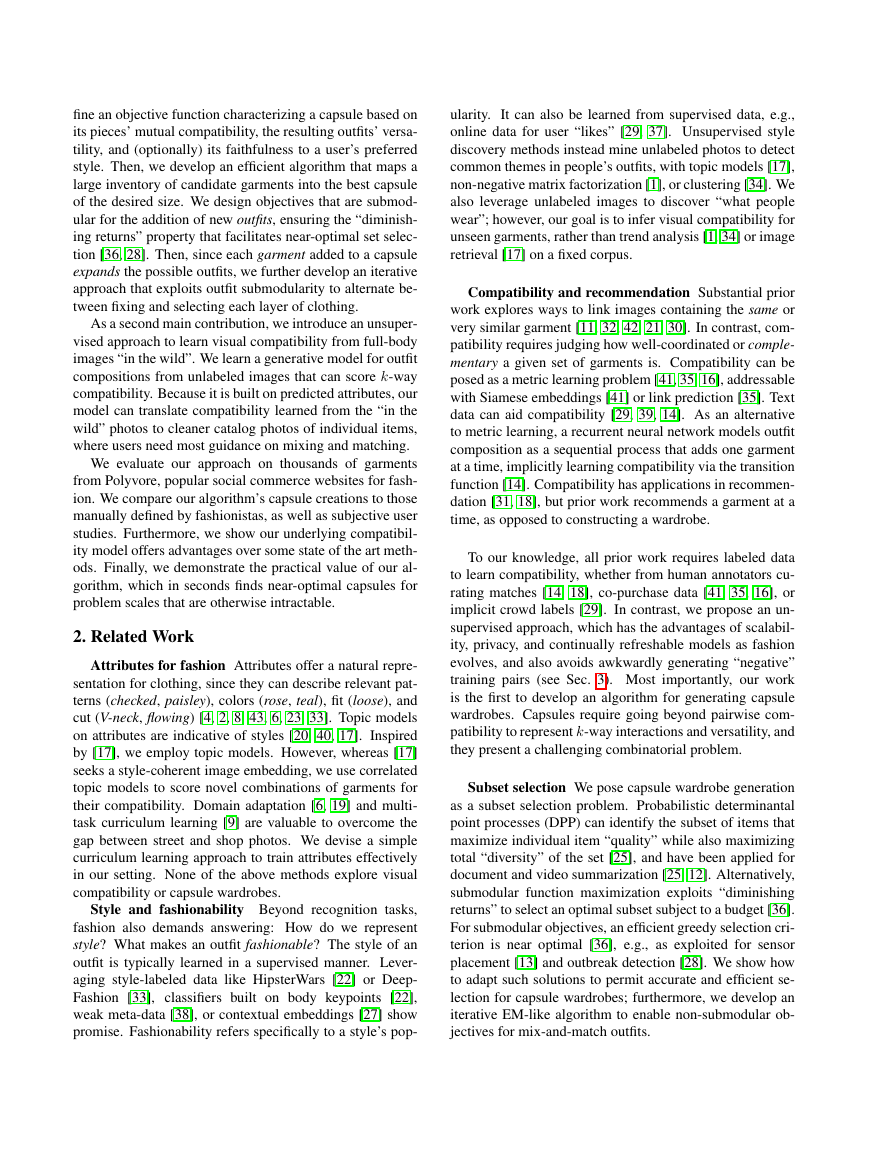
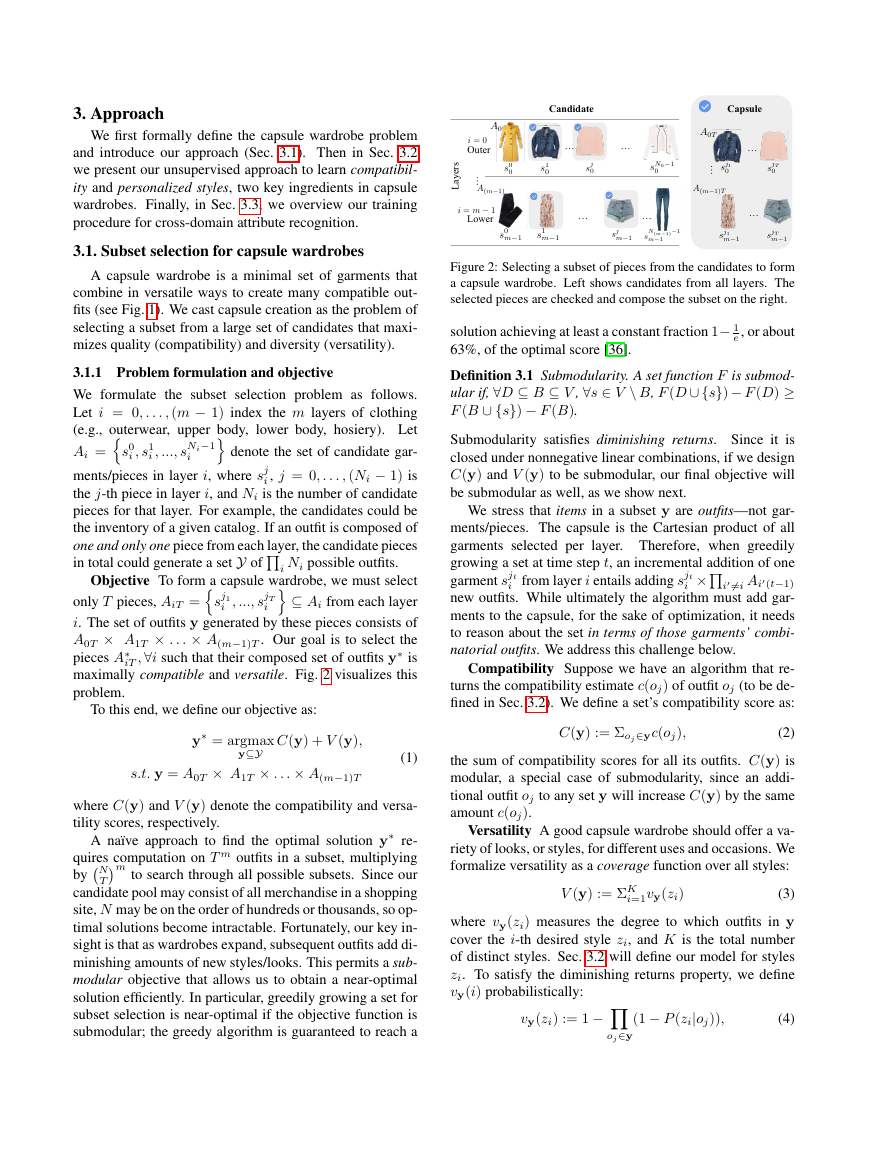
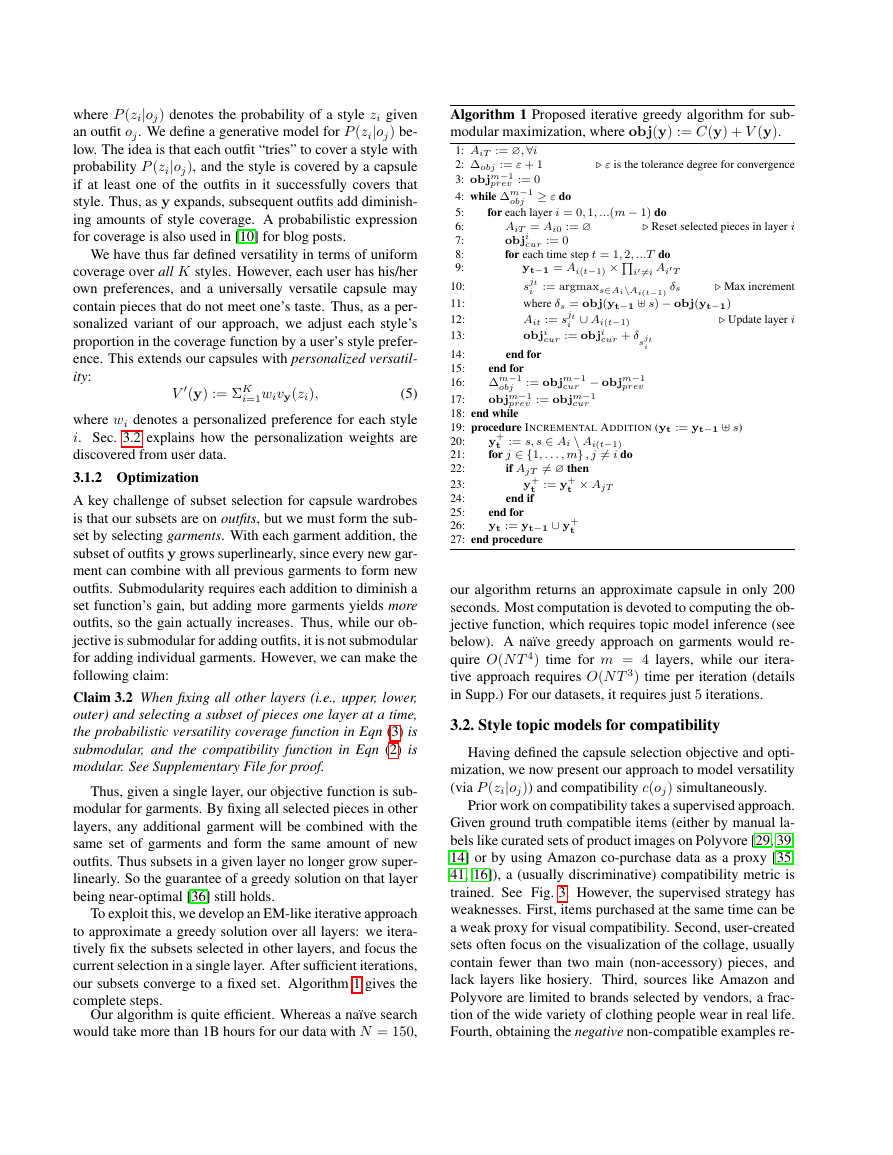
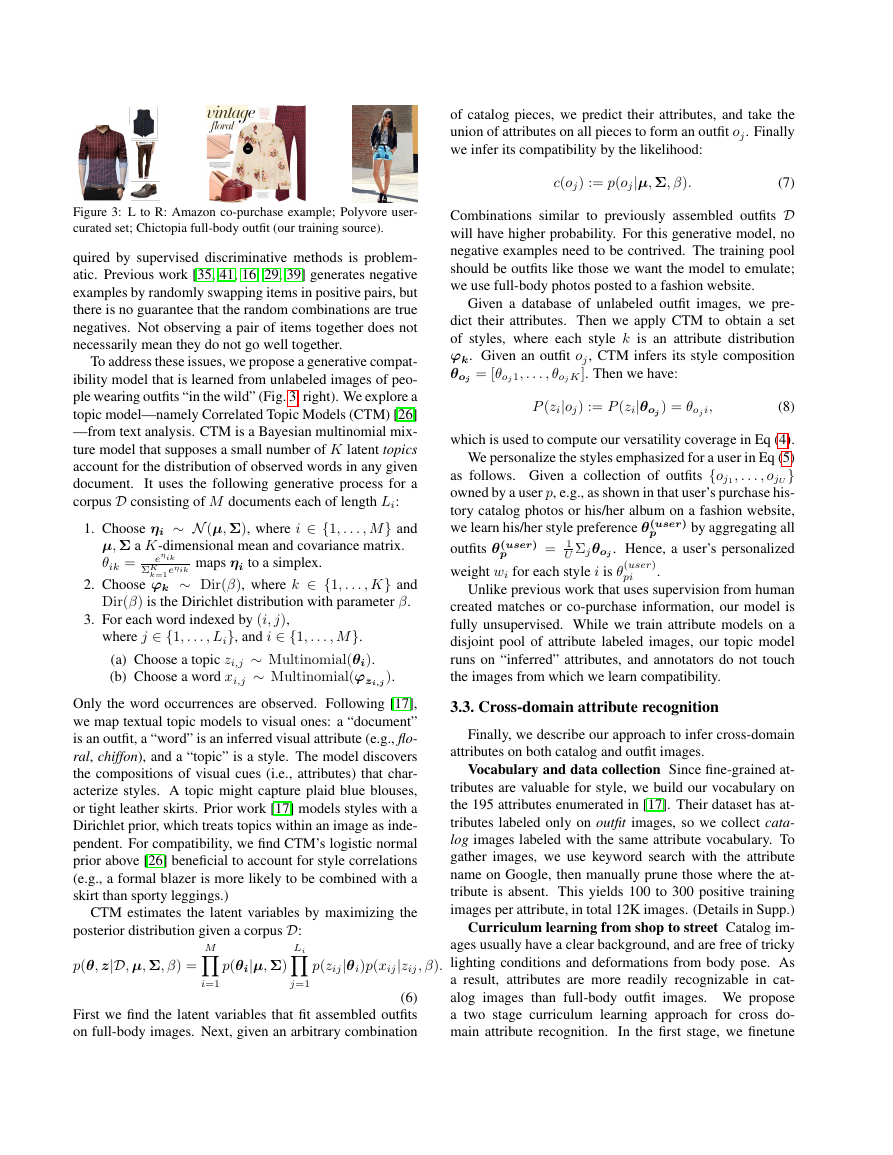
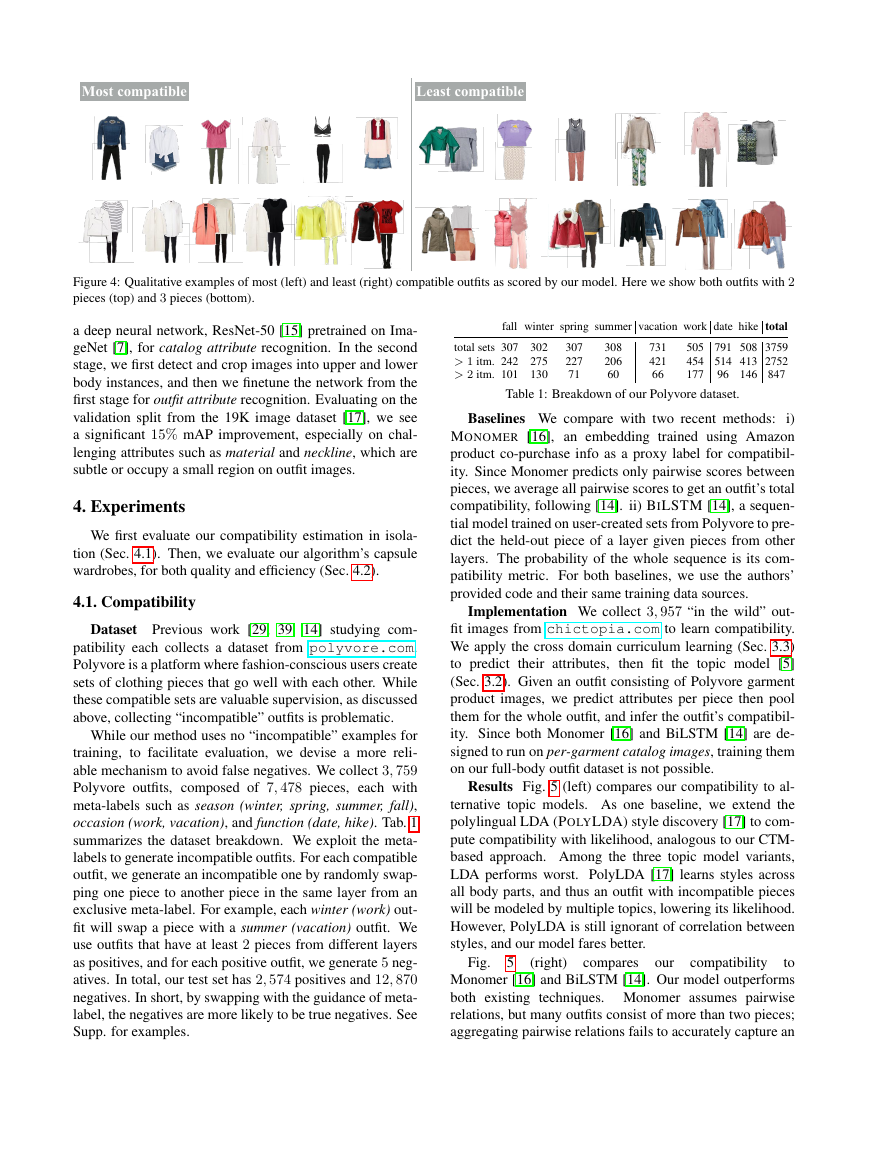
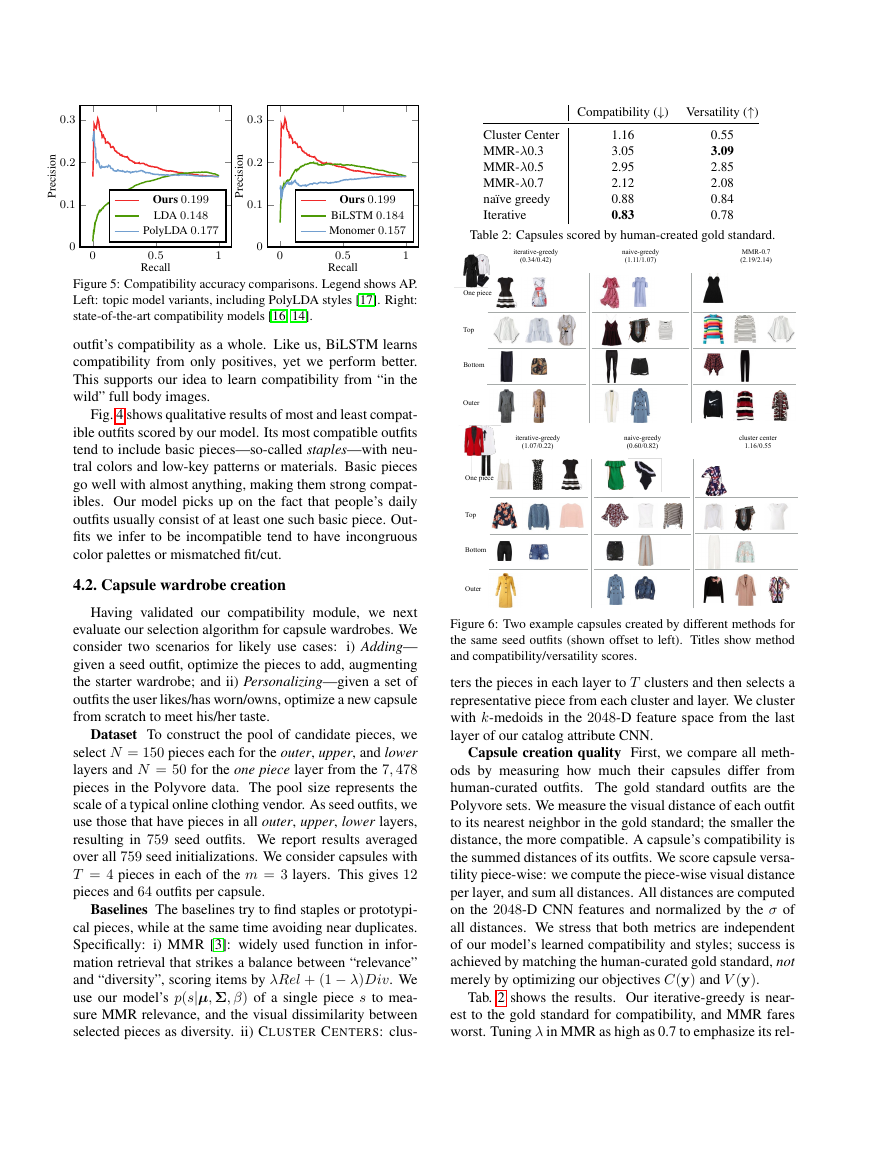
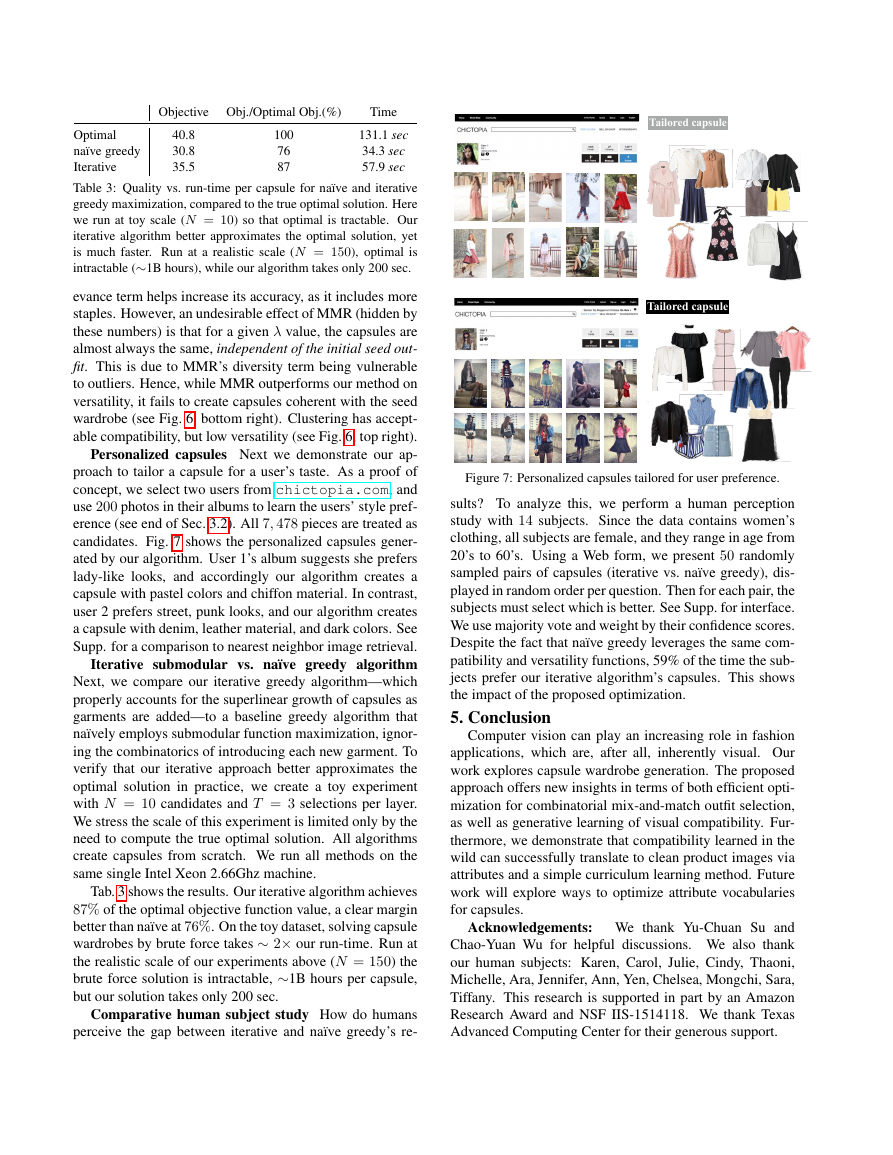








 2023年江西萍乡中考道德与法治真题及答案.doc
2023年江西萍乡中考道德与法治真题及答案.doc 2012年重庆南川中考生物真题及答案.doc
2012年重庆南川中考生物真题及答案.doc 2013年江西师范大学地理学综合及文艺理论基础考研真题.doc
2013年江西师范大学地理学综合及文艺理论基础考研真题.doc 2020年四川甘孜小升初语文真题及答案I卷.doc
2020年四川甘孜小升初语文真题及答案I卷.doc 2020年注册岩土工程师专业基础考试真题及答案.doc
2020年注册岩土工程师专业基础考试真题及答案.doc 2023-2024学年福建省厦门市九年级上学期数学月考试题及答案.doc
2023-2024学年福建省厦门市九年级上学期数学月考试题及答案.doc 2021-2022学年辽宁省沈阳市大东区九年级上学期语文期末试题及答案.doc
2021-2022学年辽宁省沈阳市大东区九年级上学期语文期末试题及答案.doc 2022-2023学年北京东城区初三第一学期物理期末试卷及答案.doc
2022-2023学年北京东城区初三第一学期物理期末试卷及答案.doc 2018上半年江西教师资格初中地理学科知识与教学能力真题及答案.doc
2018上半年江西教师资格初中地理学科知识与教学能力真题及答案.doc 2012年河北国家公务员申论考试真题及答案-省级.doc
2012年河北国家公务员申论考试真题及答案-省级.doc 2020-2021学年江苏省扬州市江都区邵樊片九年级上学期数学第一次质量检测试题及答案.doc
2020-2021学年江苏省扬州市江都区邵樊片九年级上学期数学第一次质量检测试题及答案.doc 2022下半年黑龙江教师资格证中学综合素质真题及答案.doc
2022下半年黑龙江教师资格证中学综合素质真题及答案.doc